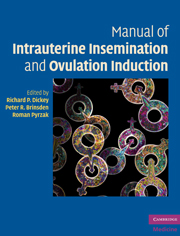Book contents
- Frontmatter
- Contents
- List of contributors
- Preface
- 1 An overview of intrauterine insemination and ovulation induction
- 2 Male causes of infertility: evaluation and treatment
- 3 Female causes of infertility: evaluation and treatment
- 4 Clinic and laboratory design, personnel and equipment
- 5 Semen analysis: semen requirements for intrauterine insemination
- 6 Semen preparation for intrauterine insemination
- 7 Ovulation induction for intrauterine insemination I: oral drugs clomiphene, tamoxifen, letrozole
- 8 Ovulation induction for intrauterine insemination II: gonadotropins and oral drug–gonadotropin combinations
- 9 Ultrasonography in the management of ovulation induction and intrauterine insemination
- 10 Insemination technique and insemination complications
- 11 Cryopreservation
- 12 Donor sperm
- 13 The role of the nurse in intrauterine insemination and ovulation induction
- 14 Complications of ovulation induction I: high-order multiple births, miscarriage, ectopic pregnancy, congenital anomalies, ovarian cancer
- 15 Complications of ovulation induction II: ovarian hyperstimulation syndrome, ovarian torsion
- 16 The psychological issues of intrauterine insemination
- 17 Ethical, legal and religious considerations of artificial insemination
- Index
11 - Cryopreservation
Published online by Cambridge University Press: 01 February 2010
- Frontmatter
- Contents
- List of contributors
- Preface
- 1 An overview of intrauterine insemination and ovulation induction
- 2 Male causes of infertility: evaluation and treatment
- 3 Female causes of infertility: evaluation and treatment
- 4 Clinic and laboratory design, personnel and equipment
- 5 Semen analysis: semen requirements for intrauterine insemination
- 6 Semen preparation for intrauterine insemination
- 7 Ovulation induction for intrauterine insemination I: oral drugs clomiphene, tamoxifen, letrozole
- 8 Ovulation induction for intrauterine insemination II: gonadotropins and oral drug–gonadotropin combinations
- 9 Ultrasonography in the management of ovulation induction and intrauterine insemination
- 10 Insemination technique and insemination complications
- 11 Cryopreservation
- 12 Donor sperm
- 13 The role of the nurse in intrauterine insemination and ovulation induction
- 14 Complications of ovulation induction I: high-order multiple births, miscarriage, ectopic pregnancy, congenital anomalies, ovarian cancer
- 15 Complications of ovulation induction II: ovarian hyperstimulation syndrome, ovarian torsion
- 16 The psychological issues of intrauterine insemination
- 17 Ethical, legal and religious considerations of artificial insemination
- Index
Summary
Introduction
The clinical use of frozen-stored human semen or sperm is practical, beneficial, safe and it provides a readily available method for the treatment of infertility and the preservation of fertility. It was known in the eighteenth century that sperm could survive freezing. However, the first published report of successful insemination of cryopreserved sperm did not appear until 1954. Since then, improvements in cryoprotectant media and freezing protocols have made sperm cryopreservation applicable for all aspects of therapeutic insemination. When human chorionic gonadotropin (hCG) injection or luteinizing hormone (LH) timing and equal numbers of progressively motile donor sperm are used for intrauterine insemination, there is no difference in pregnancy rates between fresh and cryopreserved sperm. Most clinical practices that perform large numbers of inseminations with fresh sperm will wish to be able to cryopreserve patient sperm. If a clinical practice does not itself perform cryopreservation it may still refer patients to clinics or laboratories that do, and arrange for the cryopreserved specimen to be returned to the practice for thaw and insemination, as would be done in a case of donor insemination.
The advantages of frozen sperm over fresh sperm are many (Table 11.1). Cryopreservation provides the means to disassociate sperm collection and processing from ovulation. It is always available for use. For men with low total sperm counts several ejaculates can be frozen and combined later. Conversely, for men with high total sperm counts a single ejaculate can be used in several insemination cycles if they are not always available to furnish a fresh specimen.
- Type
- Chapter
- Information
- Manual of Intrauterine Insemination and Ovulation Induction , pp. 119 - 129Publisher: Cambridge University PressPrint publication year: 2009

